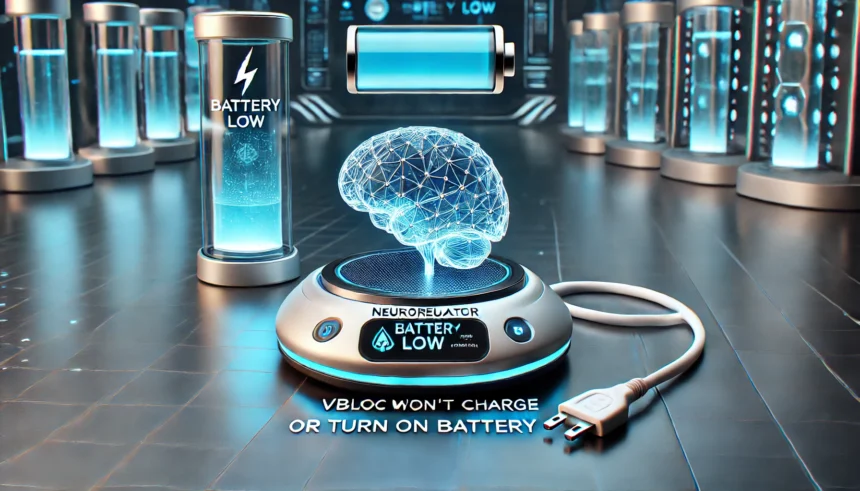VBLOC therapy is a cutting-edge treatment that helps manage weight loss by controlling hunger. The therapy uses a device called a neuroregulator, which is implanted under the skin and works with your body’s vagus nerve to reduce appetite. This device is powered by a rechargeable battery, and it is crucial that it remains charged to work effectively.
If you are facing Vbloc won’t Charge or turn on Battery issues, it can disrupt your treatment, making it essential to address the problem immediately. This article explores the common reasons why your VBLOC device may fail to charge or turn on, along with practical steps to troubleshoot and prevent these problems.
What is VBLOC Therapy?
Before diving into troubleshooting, it’s important to understand what the VBLOC system is and how it works:
VBLOC System Overview
VBLOC therapy is designed to help individuals with obesity by reducing their appetite through stimulation of the vagus nerve. The neuroregulator is implanted under the skin, typically in the upper abdomen, and works by sending pulses of energy to the vagus nerve. These pulses help to control the signals between the brain and the stomach, making you feel full and satisfied with smaller portions of food.
Key Components of VBLOC
- Neuroregulator: The implanted device that delivers pulses to the vagus nerve.
- Mobile Charger: A device used to charge the neuroregulator wirelessly.
- Transmission Coil: This is used to facilitate the transfer of energy from the charger to the neuroregulator.
- Battery: The power source for the device, which needs to be regularly charged.
To function effectively, the VBLOC system requires the battery to remain charged, and issues can arise when the device is not receiving power or is not turning on. These problems can stem from a variety of causes.
Common Reasons Why VBLOC Won’t Charge
There are a few key reasons why your VBLOC system may not be charging, and understanding these issues can help you identify the problem.
Battery Completely Drained
- What Happens: If the device has not been charged for an extended period of time, the battery may be fully drained. A completely drained battery can prevent the neuroregulator from receiving a charge, so it will not work until it has been recharged.
- Solution: Allow the device to charge for an extended period. If the battery has been drained for a long time, it may take several hours for the device to start responding to the charger.
Faulty Charging Equipment
- What Happens: The mobile charger or the transmission coil may be damaged or malfunctioning. If either of these components is not working correctly, the neuroregulator will not charge properly.
- Solution: Test the charger with another device to ensure it’s functioning properly. If the charger or transmission coil is faulty, consider replacing it with a new one.
Poor Connection Between Device and Charger
- What Happens: If there is a loose connection between the device and the charger, the device will not charge. Sometimes the charger may not align properly with the neuroregulator, or debris may be preventing the connection.
- Solution: Check that the neuroregulator is aligned correctly with the charger. Clean the device and charger to remove any dust or debris that may be interfering with the connection. Make sure the device is securely in place on the charger.
Electronic Interference
- What Happens: Devices that emit radio frequencies, such as microwaves, mobile phones, and Wi-Fi routers, can cause interference with the charging process, especially if they are located too close to the neuroregulator or the charger.
- Solution: Try charging the device in a different location, away from other electronic devices. This will help minimize interference and allow the charging process to proceed.
Software or Firmware Malfunction
- What Happens: Sometimes, the issue may not be with the physical charging equipment, but with the software that controls the device. A malfunction in the device’s software could prevent it from accepting a charge.
- Solution: If you suspect this is the issue, try resetting the device. Consult your healthcare provider for guidance on how to reset the neuroregulator. If the issue persists, a software update or repair may be needed.
Common Reasons Why VBLOC Won’t Turn On
If your VBLOC device is not turning on, there are several possible causes for the issue.
Battery Fully Discharged
- What Happens: If the battery has not been charged or has been left discharged for a long time, the device will not turn on until the battery has enough charge.
- Solution: Connect the neuroregulator to the charger and allow it to charge. If the battery was fully discharged, it may take several hours before the device is powered on again.
Temperature Extremes
- What Happens: The VBLOC neuroregulator is designed to operate within a certain temperature range (16°C to 45°C or 60°F to 113°F). Exposure to temperatures outside this range can cause the device to shut down or fail to turn on.
- Solution: Allow the device to return to a more temperate environment. Once the device is within the acceptable temperature range, it should power on as usual.
Manual Deactivation
- What Happens: If the device was manually turned off by a healthcare provider or during maintenance, it will need to be reactivated before it can turn on again.
- Solution: Contact your healthcare provider to have the device reactivated. They can reprogram the device to resume its function.
Internal Hardware Failure
- What Happens: In rare cases, an internal failure of the neuroregulator can prevent the device from turning on, even after charging.
- Solution: If all troubleshooting steps fail and the device still doesn’t turn on, it’s important to contact your healthcare provider. The device may require professional repair or replacement.
Step-by-Step Troubleshooting Guide
If your VBLOC device isn’t charging or turning on, follow these steps to troubleshoot the issue:
- Check the Battery and Charger: Ensure that the charger is functioning correctly by testing it with another device. If the charger seems to be malfunctioning, try using a different charger or cable.
- Inspect for Physical Damage: Carefully examine both the neuroregulator and charger for signs of damage. Look for cracks, loose parts, or any signs of wear that may be preventing the device from charging or turning on.
- Reset the Device: Sometimes, resetting the neuroregulator can fix the issue. Follow the instructions provided by your healthcare provider on how to reset the device.
- Move Away from Electronic Interference: If you suspect that interference from other electronic devices is affecting the charging process, try moving the device and charger to a different location with fewer electronic distractions.
- Ensure Temperature Conditions: If the device has been exposed to extreme temperatures, allow it to return to a comfortable room temperature. Once it has cooled or warmed up, attempt to turn it on again.
- Consult Your Healthcare Provider: If none of the above solutions work, contact your healthcare provider. They can offer further troubleshooting or determine if the device requires repair.
Preventative Measures to Avoid Charging and Power Issues
Regular Charging
Charge the device regularly to avoid complete battery drain. It’s a good idea to charge it at least once every few weeks to maintain the battery’s health.
Proper Storage and Handling
Keep the neuroregulator in a safe, dry place away from extreme heat or cold. Storing the device properly can help prevent damage and prolong its lifespan.
Use Approved Charging Equipment
Always use the official charger provided by the manufacturer. Using third-party chargers may cause compatibility issues and lead to charging problems.
Routine Checkups with Your Healthcare Provider
Regular checkups with your healthcare provider can help identify any potential issues before they become major problems. They can check the device’s functionality and ensure that it is working properly.
When to Seek Professional Help
If your device is still not charging or turning on despite following the troubleshooting steps, it may be time to seek professional help. Issues like battery replacement, hardware malfunction, or device repair often require professional assistance. Your healthcare provider can offer support and may need to refer you to the device manufacturer for repairs or replacement.
Conclusion
Maintaining a fully charged and operational VBLOC system is essential for the success of your therapy. If you experience Vbloc won’t Charge or turn on Battery issues, follow the troubleshooting steps outlined above to resolve the problem. Regular maintenance, proper handling, and prompt professional support will ensure that your VBLOC system continues to help you achieve your weight-loss goals.
FAQs
Why is my VBLOC device taking too long to charge?
If the battery is fully drained, it may take several hours to start charging. Ensure the charger and coil are properly aligned.
Can extreme temperatures affect my VBLOC device’s ability to charge?
Yes, temperatures below 16°C (60°F) or above 45°C (113°F) can cause the device to shut down and stop charging.
What should I do if my VBLOC device does not respond after charging?
Try resetting the device or moving it to a different location to avoid electronic interference before contacting your healthcare provider.
How often should I charge my VBLOC neuroregulator to avoid power issues?
Charge it at least once every few weeks to prevent deep discharge, which can make recharging difficult.
Can I use a third-party charger for my VBLOC device?
No, always use the approved charger, as third-party chargers may not provide the correct power and could damage the device.









